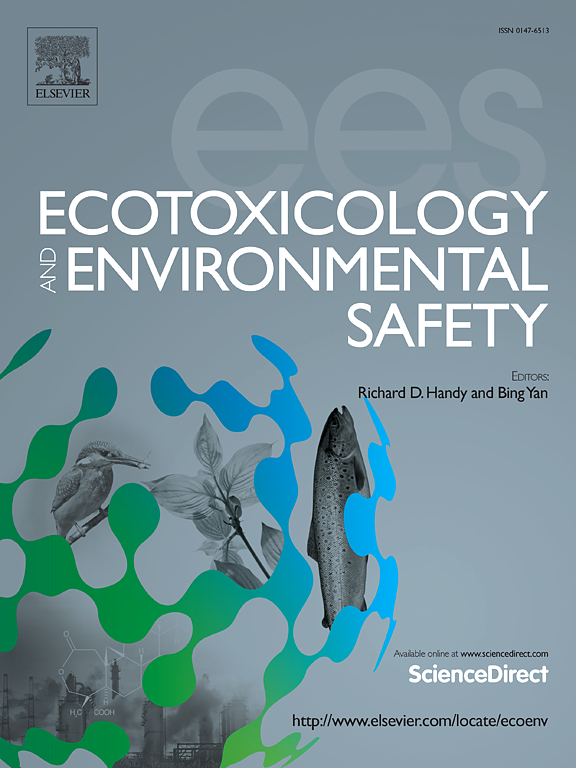探索血液细胞外囊泡中的微小核糖核酸作为暴露于多环芳烃的生物标志物。
IF 6.1
2区 环境科学与生态学
Q1 ENVIRONMENTAL SCIENCES
引用次数: 0
摘要
多环芳烃(PAHs)是一种普遍存在的环境污染物,接触多环芳烃会对人体健康产生严重的毒性影响,例如,据报道,研究最多的多环芳烃是苯并(a)芘(B(a)P),它具有致癌性和免疫抑制性改变。为了评估与这种暴露相关的风险,有必要获得预测性生物标志物。因此,细胞外囊泡(EVs)及其微RNA(miRNA)含量最近被认为是毒理学中潜在的有趣生物标志物。我们的研究探讨了如何利用血液中分泌和发现的囊泡及其 miRNA 作为单独暴露于 B(a)P,以及在现实职业混合物中暴露于 B(a)P 的生物标志物。我们从暴露于多环芳烃后的原代人类培养血液单核细胞(PBMC)和大鼠血浆中分离出了 EVs,并报告了 B(a)P(单独使用或在混合物中使用)在体外和体内增加了 EV 的产生。随后,我们研究了这种 EV 释放与大鼠血液中 7,8,9,10-羟基(四醇)-B(a)P 活性代谢物浓度之间的关系。通过对 PBMC 衍生 EV 中的 miRNA 进行 RNA 序列分析(RNA-seq),我们分析了 miRNA 图谱,并证明了 B(a)P 暴露对 miR-342-3p 表达的调控作用。然后,我们在大鼠血浆衍生的 EVs 中验证了 B(a)P 诱导的 miR-342-3p 表达的体内变化。总之,我们的研究强调了使用 EVs 及其 miRNA 含量作为多环芳烃暴露生物标志物的可行性,并讨论了它们在环境毒理学中的潜力。本文章由计算机程序翻译,如有差异,请以英文原文为准。
Exploration of microRNAs from blood extracellular vesicles as biomarkers of exposure to polycyclic aromatic hydrocarbons
Exposure to polycyclic aromatic hydrocarbons (PAHs), ubiquitously environmental contaminant, leads to the development of major toxic effects on human health, such as carcinogenic and immunosuppressive alterations reported for the most studied PAH, i.e., benzo(a)pyrene (B(a)P). In order to assess the risk associated with this exposure, it is necessary to have predictive biomarkers. Thus, extracellular vesicles (EVs) and their microRNA (miRNA) contents, have recently been proposed as potentially interesting biomarkers in Toxicology. Our study here explores the use of vesicles secreted and found in blood fluids, and their miRNAs, as biomarkers of exposure to B(a)P alone and within a realistic occupational mixture. We isolated EVs from primary human cultured blood mononuclear cells (PBMCs) and rat plasma after PAH exposure and reported an increased EV production by B(a)P, used either alone or in the mixture, in vitro and in vivo. We then investigated the association of this EV release with the blood concentration of the 7,8,9,10-hydroxy (tetrol)-B(a)P reactive metabolite, in rats. By performing RNA-sequencing (RNA-seq) of miRNAs in PBMC-derived EVs, we analyzed miRNA profiles and demonstrated the regulation of the expression of miR-342–3p upon B(a)P exposure. We then validated B(a)P-induced changes of miR-342–3p expression in vivo in rat plasma-derived EVs. Overall, our study highlights the feasibility of using EVs and their miRNA contents, as biomarkers of PAH exposure and discusses their potential in environmental Toxicology.
求助全文
通过发布文献求助,成功后即可免费获取论文全文。
去求助
来源期刊
CiteScore
12.10
自引率
5.90%
发文量
1234
审稿时长
88 days
期刊介绍:
Ecotoxicology and Environmental Safety is a multi-disciplinary journal that focuses on understanding the exposure and effects of environmental contamination on organisms including human health. The scope of the journal covers three main themes. The topics within these themes, indicated below, include (but are not limited to) the following: Ecotoxicology、Environmental Chemistry、Environmental Safety etc.

 求助内容:
求助内容: 应助结果提醒方式:
应助结果提醒方式:


